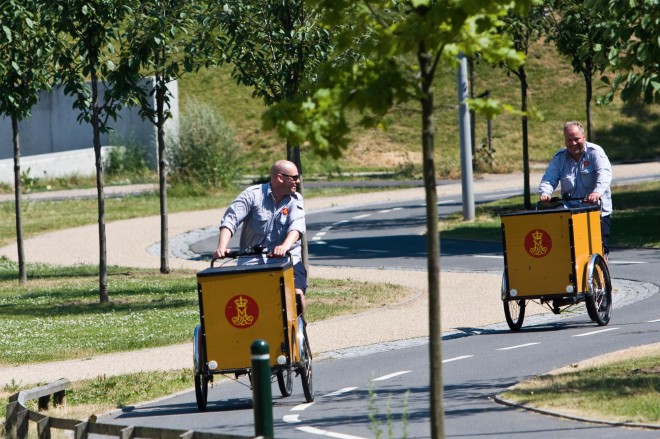
The future of urban delivery: the cargobike and the Cycle Logistics Federation

As major European cities have developed and expanded over the years, they have also become increasingly congested and harder to navigate. One creative solution to this onslaught of traffic is the cargobike. Able to carry a variety of items of different weights, read on to discover what the cargobike has done and continues to do for the way we think of transportation and delivery in Europe; and how the Cycle Logistics Federation is working to solidify these thoughts.
In places like Copenhagen or Amsterdam, the sight of three kids, a Christmas tree, or a couch piled up in what looks like a box attached to the front of a bike, would not be the subject of too many double-takes, weary glances, or generally confused faces. In cities like these, this sight is more or less commonplace; and the cargobike is something that has established itself as a recognizable and accepted method of moving goods in these urban centres. The new lobby group, Cycle Logistics Federation believes that it’s about time that the commonality of the cargobike spread to everywhere else.
So what is a cargobike, exactly?
Cargobikes are essentially freight bikes; meaning that they are human and pedal-powered vehicles with the capacity to carry light goods around town. What can they carry? For instance, cargobikes have found themselves to be the favoured form transportation of goods ranging from food, to mail, to furniture, to pets and even kids. Peter Walker, of the Guardian UK exemplifies the diverse capacities of the cargobike, stating that smaller two-wheeled versions are able to carry up to roughly 250kg, and larger 3 or 4-wheeled versions with the capacity to load on up to about 400kg.
July 14, 2012, 40 organisations from across Europe are will attend the first ever meeting of the Cycle Logistics Federation
Cargobikes are also normally and primarily used in urban areas, for several reasons. Why? Firstly, have you ever found yourself sitting in traffic, doing anywhere from 0-10km/hr on a crowded street? Well take that frustration and multiply it by what Cycle Logistics, a European Union-funded project with expert knowledge on transportation and cycling estimates as “almost 100% of goods transport within cities [being] done by motorised vehicles, ranging from personal cars to commercial lorries”. Given this level of traffic, congestion [and headache] in major cities, the cargobike is quickly becoming a suitable and even favourable solution to delivery transportation.
Further solidifying this point, Gary Armstrong, of the UK’s Outspoken Delivery acts as voice from Cambridge, one of England’s busiest cities:
"Freight bikes can deliver to inner city centres which vans/lorries cannot easily access and probably  quicker as they can cut through and bypass congestion.” Says Armstrong.
quicker as they can cut through and bypass congestion.” Says Armstrong.
One doesn’t need to read this over too many times to think, not only of the amount of time that transport by cargobike can save by zipping through areas that are not easily accessible by traditional automobiles; but also, of the famous adage that time is money – and considering that “every second trip in urban areas is shorter than 5km” as stated by the Cycle Logistics project, the cargobike can act as a source of a bit of extra change.
Not convinced? Well, of course, aside from “reducing noise and pollution” in urban centres, as stated by the Cycle Logistics project, a bike runs on nothing but leg-power and conviction; whereas a lorry, automobile or motorized scooter runs on petrol – and sometimes plenty of it. Thus, cargobikes gain the added advantage of sustainability through “green credentials with zero carbon emissions”, topping the list as an environmentally-friendly mode of delivery, as well as a cost-efficient one.
Further, the Cycle Logistics project believes that about “25% of all trips can be shifted from motorized vehicles towards cycling-related solutions”. Consequently, this would mean a lot of things: from increased space for citizens to enjoy their cities; to a higher and healthier quality of life for inhabitants, to cleaner air and quieter streets. Given all of the above and many more, the widespread use of cargobikes is something that is undoubtedly bound to conjure up some positive and lasting changes to our urban centres in Europe.
Still, ever thought that cargobikes would up and form a federation?
Well, they themselves haven’t. However, on July 14, 2012, 40 organisations from across Europe are due to attend the first ever meeting of the Cycle Logistics Federation. The Federation is comprised of members ranging from the European Cyclists’ Federation, to the UK’s Outspoken Delivery, to Copenhagenize Consulting, and many more. A lobby group that aims to make the long-lasting benefits of cargobikes evident to stakeholders, policy-makers, companies and citizens alike, the Cycle Logistics Federation is on its way to changing how we think of delivery and transportation in Europe – with nice legs, to boot.
About the Author
 Alexandra Cutean is the Communications Assistant at ECF and a long-time cyclist. With a background in conflict resolution and European Affairs, she spends most of her spare time looking for new places to visit, and mapping out bike routes.
Alexandra Cutean is the Communications Assistant at ECF and a long-time cyclist. With a background in conflict resolution and European Affairs, she spends most of her spare time looking for new places to visit, and mapping out bike routes.
Contact the author
Recent news!
Upcoming events
Contact Us
Avenue des Arts, 7-8
Postal address: Rue de la Charité, 22
1210 Brussels, Belgium










